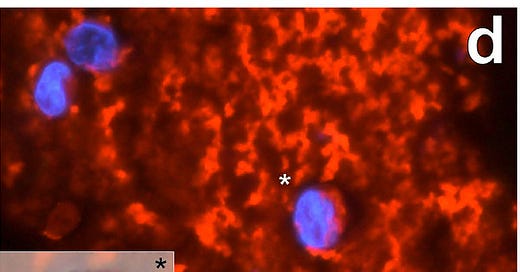One penny is a loose approximation of the cost of aluminium adjuvant included in a vaccine. It is almost certainly a lot less than a penny but you can guess where I am going with this. I am writing about this subject again following a question I received from Jennifer Margolis, a supporter and friend. Jennifer has written this post and received a correction in a post comment. She wanted to check with me if the ‘correction’ was correct. It isn’t but it did demonstrate to me that we are quite far from a consensus opinion on how aluminium adjuvants really work. This is, of course, the question I raised in my seminal paper in Trends in Immunology back in 2010. Ten years further on in 2020 I was pretty confident that I knew the answer. Today I remain as confident though I no longer have the laboratory and research team to test my premise thoroughly.
If you take the time to read Jennifer’s excellent post and the criticism levelled at her in the comments it might just make you smile. It certainly brought a wry grin to my face. Why? Well, because biology, biochemistry, chemistry whatever you will, there is no conscious element here. Just chance and Darwinian natural selection. What do I mean? Let’s go through what happens when you receive a vaccine that includes an aluminium adjuvant. Your agreement to receive the injection is the last act of consciousness on your behalf. The rest is biochemistry and natural selection.
What if for some reason your vaccine did not include the aluminium adjuvant, just the antigen. Well the answer is that absolutely nothing would happen. Not enough foreign material, antigen, for the body to bother about. Measurements would show that effectively no antibodies against the antigen had been raised. So, what if for some reason your vaccine included 100 times more antigen and still no aluminium adjuvant. Well, I am guessing with the factor of 100 but bags of antigen would be sufficient to initiate the immune response and raising of antibodies against the antigen. Bingo! If you believe in vaccinology then this would be an effective vaccine against the injected antigen. So, why don’t they do this, why bother with their ‘dirty little secret’ the aluminium adjuvant. I know that you are ahead of me but….the antigen is by far the most expensive component of any vaccine. It is essentially the cost of the vaccine and therefore it determines the margin, the profitability of the vaccine. If they had to use 100 times more antigen for the vaccine to be effective then the vaccine would be 100 times more expensive and no longer profitable.
This is the economic genius of including an aluminium adjuvant. For some reason, apparently wholly unknown as to why to the manufacturers and vaccine ‘Gods’ alike, the inclusion of an aluminium adjuvant with an infinitesimally small amount of antigen produces an effective antibody titre against the injected antigen. It’s a miracle (of profitability). So how does the inclusion of an aluminium adjuvant, the industry’s not so secret, ‘dirty little secret’ make all the required difference.
As I intimated earlier in this post, the injection of an aluminium adjuvanted vaccine is equivalent to an acute exposure to aluminium at the injection site. Take a look at the image below taken from one of our papers.
The blue colour is DAPI staining of nuclei of THP1 cells ( a model of the type of monocytes known to invade the vaccine injection site). The bright orange is aluminium adjuvant though more specifically it is an indicator of the availability of the acutely toxic free metal cation Al3+. It is a visual representation of how much cytotoxic Al3+ is available in the vicinity of the injection site to produce a significant inflammatory response. It is this inflammatory response that is key. It initiates a cascade of invading immune reactive cells to the vaccine injection site. It is recognition that aluminium adjuvant is also ‘foreign matter’ and must be dealt with by the various defence mechanisms of the body. Many of the invading cells are phagocytic, such as macrophages, and they ‘eat’ the particles of aluminium adjuvant accumulating it in membrane bound vesicles within their cytoplasm. By chance some of these particle may also have antigen associated with them. Indeed these phagocytes infiltrating the vaccine injection site will also take up any free antigen they encounter. Their role is to ‘neutralise’ any foreign substance that they come across at the vaccine injection site. Some of these cells will carry their cargoes to the lymph nodes where antigens and aluminium alike will be processed and an immune response initiated. Antibodies will be raised against not only the vaccine antigen but also against aluminium. The former, antibodies against the antigen, form the basis for the vaccine and these are measured by vaccine manufacturers as an indication of the effectiveness of the vaccine. The latter, antibodies against aluminium, are not measured. Indeed they are not even considered as consequential.
So, aluminium adjuvants are effective in magnifying the potency of infinitesimally small amounts of antigen because they are acutely toxic at the vaccine injection site. If the toxicity of aluminium adjuvants remained at the vaccine injection site then their use might be tolerated. We know that this is not their reality and this is why aluminium salts should no longer be used as adjuvants in vaccines, regardless of how many pennies of profit they make for the vaccine industry.





And now I finally understand why aluminum is added to vaccines. Thanks. Doesn’t it always come down to money?
The ingredients of a vaccine become moot if one never injects anything into the body.